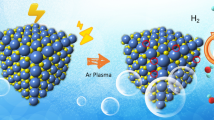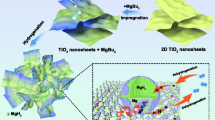Abstract
The temperature-programmed desorption (TPD) of N2 from a Ru/MgO catalyst used for ammonia synthesis was studied in a microreactor flow system operating at atmospheric pressure. Saturation with chemisorbed atomic nitrogen (N-*) was achieved by exposure to N2 at 573 K for 14 h and subsequent cooling in N2 to room temperature. With a heating rate of 5 K/min in He, a narrow and fairly symmetric N2 TPD peak at about 640 K results. From experiments with varying heating rates a preexponential factor Ades = 1.5×1010 molecules/(site s) and an activation energy Edes = 158 kJ/mol was derived assuming secondorder desorption. This rate constant of desorption is in good agreement with results obtained with a Ru(0001) single crystal surface in ultra-high vacuum (UHV). The rate of dissociative chemisorption was determined by varying the N2 exposure conditions. Determination of the coverage of N-* was based on the integration of the subsequently recorded N2 TPD traces yielding Aads = 2×10−6 (Pa s)−1 and Eads = 27 kJ/mol. The corresponding sticking coefficient of about 10−14 at 300 K is in agreement with the inertness of Ru(0001) in UHV towards dissociative chemisorption of N2. However, if the whole catalytic surface were in this state, then the resulting rate of N2 dissociation would be several orders of magnitude lower than the observed rate of NH3 formation. Hence only a small fraction of the total Rumetal surface area of Ru/MgO seems to be highly active dominating the rate of ammonia formation.
Similar content being viewed by others
References
S.R. Tennison, in:Catalytic Ammonia Synthesis, 1st Ed., ed. J.R. Jennings (Plenum Press), New York, 1991 p. 303.
K. Aika, T. Takano and S. Murata, J. Catal. 136 (1992) 126.
L.R. Danielson, M.J. Dresser, E.E. Donaldson and J.T. Dickinson, Surf. Sci. 71 (1978) 599.
Y. Ogata, K. Aika and T. Onishi, Surf. Sci. 140 (1984) L285.
T. Matsushima, Surf. Sci. 197 (1988) L287.
H. Dietrich, P. Geng, K. Jacobi and G. Ertl, J. Chem. Phys., submitted.
C. Egawa, S. Naito and K. Tamaru, Surf. Sci. 138 (1984) 279.
W. Tsai and W.H. Weinberg, J. Phys. Chem. 91 (1987) 5302.
H. Rauscher, K.L. Kostov and D. Menzel, Chem. Phys. 177 (1993) 473.
J.F. Parmeter, U. Schwalke and W.H. Weinberg, J. Am. Chem. Soc. 110 (1988) 53.
K. Kunimori, M. Osumi, S. Kameoka and S. Ito, Catal. Lett. 16 (1992) 443.
T. Birchem and M. Muhler, Surf. Sci. 334 (1995) L701.
H. Shi, K. Jacobi and G. Ertl, J. Chem. Phys. 99 (1993) 9248.
C. Egawa, T. Nishida, S. Naito and K. Tamaru, J. Chem. Soc. Faraday Trans. I 80 (1984) 1595.
M. Muhler, F. Rosowski and G. Ertl, Catal. Lett. 24 (1994) 317.
O. Hinrichsen, F. Rosowski and M. Muhler, Chem.-Ing.-Tech. 66 (1994) 1375.
K. Aika and K. Tamaru, in:Ammonia: Catalysis and Manufacture, 1st Ed., ed. A. Nielsen (Springer, Berlin, 1995).
B. Fastrup and H.N. Nielsen, Catal. Lett. 14 (1992) 233.
T.Z. Srnak, J.A. Dumesic, B.S. Clausen, E. Törnqvist and N.-Y. Topsøe, J. Catal. 135 (1992) 246.
H. Knözinger, Y. Zhao, B. Tesche, R. Barth, R. Epstein, B.C. Gates and J.P. Scott, Faraday Discussions Chem. Soc. 72 (1982) 53.
P. Moggi, G. Predieri, G. Albanesi, S. Papadopoulos and E. Sappa, Appl. Catal. 53 (1989) L1.
R.A. Dalla Betta, J. Catal. 34 (1974) 57.
F. Rosowski, A. Hornung, O. Hinrichsen, M. Muhler and G. Ertl, Appl. Catal., submitted.
J. Trost, Thesis, Freie Universität Berlin, Germany (1995).
Y.-K. Sun, Y.-Q. Wang, C.B. Mullins and W.H. Weinberg, Langmuir 7 (1991) 1689.
X. Wu, B.C. Gerstein and T.S. King, J. Catal. 118 (1989) 238.
Y. Izumi, M. Hoshikawa and K. Aika, Bull. Chem. Soc. Japan 67 (1994) 3191.
J.A. Dumesic, D.F. Rudd, L.M. Aparicio, J.E. Rekoske and A.A. Trevino,The Microkinetics of Heterogeneous Catalysis, ACS professional reference book (Am. Chem. Soc., Washington, 1993).
F. Rosowski, O. Hinrichsen, A. Hornung, M. Muhler and G. Ertl, Catal. Lett., in preparation.
Author information
Authors and Affiliations
Rights and permissions
About this article
Cite this article
Rosowski, F., Hinrichsen, O., Muhler, M. et al. The temperature-programmed desorption of N2 from a Ru/MgO catalyst used for ammonia synthesis. Catal Lett 36, 229–235 (1996). https://doi.org/10.1007/BF00807624
Received:
Accepted:
Issue Date:
DOI: https://doi.org/10.1007/BF00807624




